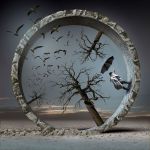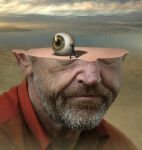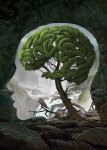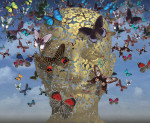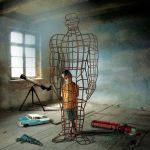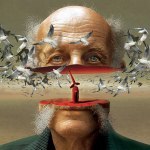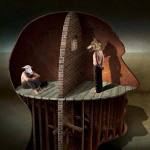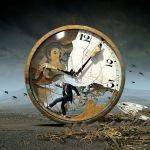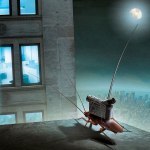Rick Wayne's Blog, page 47
May 26, 2019
May 25, 2019
Ben Nicholas – “Holy Navigator Khepri”
[image error]
Ben Nicholas – “Holy Navigator Khepri”
May 23, 2019
A New Cover!
[image error]
This book is highly unusual. To start, it isn’t one story. It’s five mysteries, or “courses” (as in a meal). Each is told by a different narrator. Each not only completes a full narrative arc for that narrator but contributes to the larger story: a battle between the world’s greatest sorcerer, who is never the POV character, and his unseen foe.
Each course is pulp-novel-length, which means collectively the story is quite long. But again, it’s told through five distinct narrative arcs, each in a different voice. Since a tension-resolution is never very far away, the reader experience is (hopefully) not one of tedium.
The length poses some commercial challenges, however. 85% of my sales are digital, but that doesn’t mean I can ignore the print market. Small producers like me only produce paperbacks economically through services that have specific drawbacks. In short, my printer can’t handle a single volume of this size.
Even if they could, frankly, such a tome would be very unwieldy, all of which necessitates breaking the story into two parts. Part 1 ends on a (unintentional) cliffhanger right at the climax of the third mystery. Part 2 includes the conclusion, a short fourth course — sort of like the calm before the storm — and the whole of the fifth, which I have been working on for over a year and which is a full novel in and of itself.
The narrator of the fifth course is introduced in earlier mysteries, where we eventually discover she is immortal. As such, the final mystery braids two narrative strands:
a flashback to episodes from her long life, culminating in her first adventure with the sorcerer, where that adventure, we discover at the end, is also the origin of the central conflict of the entire book, and
the “real-time” conclusion of the multi-year battle.
The chapters of the fifth course alternate between these two stands, similar to what Ursula Le Guin did in “The Dispossessed.” In many cases, lessons or items the character earned in the flashback chapters come to be relevant in the very next “real-time” chapter.
Obviously, because the book is being produced in two parts, the first of which will be available shortly, I need two covers. I’m pretty sure the image below will be the second, which I decided doesn’t need to be as immediately captivating as the first. That doesn’t mean it can be dull — merely that readers will make their decision to purchase or not based on where they will start reading.
However, the second cover does need to have a similar “feel” such that the books are clearly linked. Unlike a book series — as with my last project, THE MINUS FACTION — I don’t think these covers need to have the same layout but with different figures/poses and a different foreground color, which is how most series create visual continuity.
I said in a comment the other day that covers have nested priorities. First and foremost, they need to communicate the genre, setting, and tone (or primary emotion) of the book — where the function of fiction is to give the reader a satisfactory emotional experience — so that readers have a sense of what they’re buying. Movie posters have to do the same.
After that, the title needs to be clearly legible at Amazon thumbnail size — less so the author’s name, unless that’s a significant selling point. If you look at a typical Stephen King book, for example, his name takes up more space than either the title or the art. This is because, whether readers are conscious of it or not, they treat authors as brands, and the psychology and purchasing behavior are the same.
Good covers also visually pose a genre-relevant question or conundrum that they don’t resolve. Thriller covers often try to create tension. (Will the heroine survive?) A horror cover might invoke morbid curiosity. (What horrible monster lurks under the basement?) And so on.
Only at the end of all that do you shoot for that elusive “something else,” what we might call visual appeal, which is almost impossible to define. Many covers lack it simply because 1) it’s very difficult to achieve, especially given other constraints, and 2) it’s less important — not unimportant, but less important — than those constraints, at least from a commercial point of view.
As an author and occasional hack cover designer, I am in the minority when I say covers do not actually need to depict a scene from the book. This is because covers are explicitly not for fans of the book, or for anyone who’s already familiar with it. They’re for new readers exclusively.
That’s not to say a cover can misrepresent the book. Readers absolutely shouldn’t feel tricked or cheated. But it need only capture the figurative rather than the literal content of the pages.
The now-classic example of this is the Harry Dresden series. Every cover depicts the titular wizard-detective in a broad-brimmed hat because whoever designed the original cover decided that’s what a wizard-detective should look like. Every cover since has depicted Harry in that hat, despite that he doesn’t actually wear one.
The cover above resonates with me deeply because, besides checking most of the boxes outlined above, depending on your tastes, it actually does tie to a scene in the book, and not just any scene, but the climactic scene of the entire two-volume epic occult mystery, in which high forces of light and shadow face each other with the world between.
May 21, 2019
(Art) The Acid Orgies of Lauren YS (NSFW)
[image error]
Street artist and illustrator Lauren YS creates frenetic technicolor fancies featuring strong female subjects taking flight or flaunting their sexuality or the gaze of others in fun and deliberately provocative ways. Her works are inspired by animation, mythology, literature, and her own personal narrative and have been featured in festivals around the world.




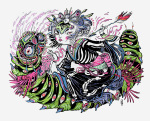
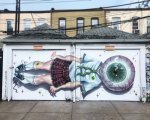
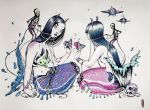
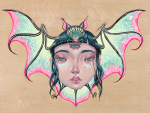
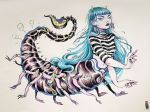
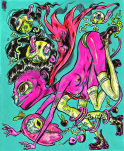
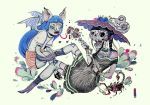


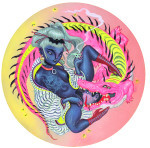
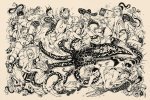


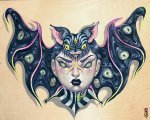
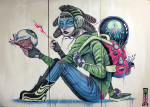
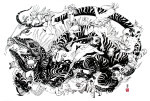
May 19, 2019
May 17, 2019
(Fiction) The Bone Labyrinth
[image error]
“Well, there’s only two reasons people come here.” He held up one finger. “Something bad.” He held up a second finger. “Something worse.”
“Worse, huh? So why drive out the day before just to turn around and go home?”
“Case the joint,” he said, like it was the most obvious thing in the world. “Guy like that”—he nodded to my phone—”What is he, a preacher or something?”
“Something like that.”
“Guy like that isn’t too sure he can take care of himself, know what I mean? But he’s up to no good, so he’s gotta come by himself. Preachers are into some weird shit, man. Trust me.”
“Not this guy.”
“No crypto or kiddie porn or anything like that? You sure?”
I nodded.
My new friend thought for a moment. “Information, maybe? Meeting somebody here? Maybe it went bad?”
“Right, right. He meets someone, but something’s not right. He gets spooked. And for whatever reason, his phone’s dead, so he can’t call for help. And he doesn’t trust the police. His lawyer made that clear. So . . .” I looked up and down the road again. “What does he do?”
My adviser shrugged nonchalantly. “He hides.”
“He hides . . .” I repeated as I scanned the scene again.
Across the street, one block down a side road, there was an abandoned apartment complex. Looked like it was in the middle of being demolished. There was a fence, but it had been bent in several places. Inside were three identical housing blocks, parallel to each other, each two stories tall. Their lower halves were covered in faux stone, which was falling off in rectangular panels. Their upper halves were all shingled, except for where the windows poked through, like they used to do back in the ‘70s. Demolition had started. I saw a pair of those giant movable trash bins they roll in for renovation projects—big metal monstrosities that get dropped off and hauled away by semi. Pieces of broken drywall poked up at an angle. Looked like they’d been there for a while, exposed to repeated bouts of rain and sun.
“Naw, man.” I was warned before taking my first step. “I wouldn’t go there.”
I looked at it. I looked at him. “Why not?”
“No one goes there. Not even when there’s snow on the ground and it’s witch-titty cold out.”
“Why?”
He shrugged. “Some places are just bad.”
“Bad,” I repeated. I reached into my pocket. “Do me a favor.” I handed him a twenty and Ollie’s card. “If I don’t come out of there in ten minutes, run down to the gas station and call that number. Can you do that?”
He looked at the cash. Then he took it. “Sure thing, pal. Your funeral.”
I crossed the street and read the warning sign that had been posted. It said the lot was being developed. Only it wasn’t. Construction had clearly stopped months ago, another dead-end husk in a marginal neighborhood left to rot by people who’d never even seen the place. There was a gap in the fence where it had started to lean, and I squeezed my way through. Each of the three identical buildings on the lot had an open stairway at the middle, with hallways flanking to the right and left. The roof of the first structure had been torn down by a backhoe, or so it seemed. The whole front of the building had been ripped open. There was no way in through all the debris. It seemed an odd place to stop work. Couldn’t have been that much more money to level the building and avoid the potential lawsuit.
I walked to the second structure. The aluminum gate that blocked the central alcove was locked. But it was old and worn. I grabbed the bars and shook and it rattled loudly. I stepped back. There was a long, U-shaped metal bar in the debris—bent, but workable—and I wedged it between the gate and the wall. I pulled. When that didn’t work, I pressed hard against it. Still nothing. I took off my bag and bounced against the bar, over and over, with my arms out, using my momentum to increase the force of my weight. Harder and harder and harder. I gritted my teeth. I growled. It felt good. Like letting off steam. I started imaging I was hitting the man my wife had slept with. Harder. Harder.
It snapped. The metal bar tore the back of my hand as I flew forward into the faux-stone siding. My cheek got scraped pretty bad. It stung when I touched it. I twisted my knee as I fell. And I felt like an idiot. But it had worked. I hadn’t actually broken the lock, but I’d bent the aluminum catch for the deadbolt. I got up and touched my face again gingerly. That’s when I noticed my hand was bleeding. I had some tissues in my bag, and I held them firm over the wound as I walked up the steps. The air smelled of stale cat piss and old wood, and there was a slight metallic tinge underneath, probably from the exposed pipes. Piles of debris had been left by the workers. Doors were either open or missing. Several walls were bare to the interior. Insulation hung unevenly from the ceiling like strips of flesh. The whole thing reminded me of a roadside carcass halfway through being scavenged clean.
I turned down the left hall, where the floor not only groaned but bowed under my weight, but there was nothing but trash and waste. Not wanting to risk a collapse, I turned and walked the opposite way. I was almost to the far end when I stopped suddenly.
I walked backward five steps.
Just past the third door from the center there was a long narrow hole, about knee high, where two boards had been knocked out. The wood was thin. It was also old and dry. The splinters were bent outward. Toward the hall. All the other debris bent in, as if the workers had been standing in the rooms with hooks, pulling it all down. But this was bent out.
I knelt and looked closer. Through the gap, I saw a symbol.
I stepped into the room. A pair of old mattresses had been fixed over the windows. Along with the boards on the exterior, they blocked most of the afternoon light—all except a thin shaft that snuck in at the top. Brown wall peeked from irregularly torn wallpaper. Someone had recently spray-painted three big words in yellow-green glow-in-the-dark paint:
PREPARE THE WAY
Underneath was another symbol: an upside-down triangle offset with swooping curves tipped in little circles. I snapped a picture with my phone. What did it mean? I reached to touch it but stopped at the last moment. I felt like I was being watched.
I turned my head and listened.
Nothing. Quiet. Not even the distant rumble of a passing car.
I caught movement. Something small. Behind me. And I turned around. There was a jagged hole in the opposite wall, about chest height. It didn’t go all the way through. It merely exposed the interior space, which was dark enough that I couldn’t see anything. A wasp walked along the lip. Another flew out of it, lazily, and landed on the ceiling. I saw its antennae move and its wings twitch as it crawled. I scowled.
There are all different kinds of wasps, of course. Not all of them have wings, but they’re all nasty, vicious creatures—aggressive and armed. Wasps account for four of the six most painful stings in the world, and unlike bees, which sacrifice themselves for the hive, wasps don’t die after stinging you. They can go right on doing it. Over and over.
Many species of wasp hunt benign, helpful insects. Others are parasites. The females of one species use the barb on their abdomens to inject their eggs into the bodies of caterpillars, which get eaten alive by the babies from the inside out. Another species is effectively a vampire, living entirely off the blood of the creatures they capture, paralyze, and drain.
Two more insects flew lazily out of the gap. They seemed oblivious to my presence. They were busy preparing for winter.
That hole, though.
Dark. Still. And I had the most uncanny feeling.
I remembered my little brother. And a shed near an abandoned church.
As I stepped closed to examine the hole, I realized the wall at the back of the closet had been knocked away. Another mattress lay against it, covering it from the other side. I walked over and pushed it out of the way. Beyond was another room. Long. Tall. Longer and taller than seemed possible for the building. The whole of it was dim and decaying, like the rest of the place. I stepped in. It took my eyes a few moments to adjust. At first I thought the ridges on the floor were exposed boards. But they weren’t. They were bones. Hundreds, at least. Animal bones. Not discarded. Not tossed in piles. They had been organized, like with like, in a large radiating circle. The smaller bones were near the center, the larger ones at the rim. In a gap at the center sat the skeleton of no creature that had ever existed. Bones of different species had been fixed together. It was about the size of a large dog and sat up, like a bear on the ground, facing the wall to my left. In front of it, as if carrying its gaze to the horizon, the bones of the circle were turned relative to the rest and made a kind of ray pattern. The rest of the collection made a complex labyrinth.
The skeleton’s skull seemed to be that of a deer. Large antlers rose from the crown, like the creature was the King of Death surrounded by an army of loyal supplicants. And there was something in its mouth. It almost looked like . . .
I took a careful step, planting the tip of my shoes in a gap between bones, a passage of the labyrinth. I barely had time to shift my weight before I heard a creak in the hall, as if someone had tread the weakened floor. I turned my head and listened again. But there was nothing. Either nobody was there, or they were doing the same as me—breathing shallow, trying not to make a sound. A minute passed like that. Then two. My legs were getting stiff. My sore knee burned. But I didn’t dare shift my weight. I thought—but couldn’t be sure—that I heard the sound of faint, distant scratching.
Three minutes passed. I didn’t move. Then four.
Were they out there?
I took a single step out of the bone circle.
Nothing.
In the near-silence, I heard the sound of a drop hit the floor. A spot of my own blood had fallen from the cut in my hand. In seconds, a wasp landed on it, its abdomen throbbing. I stepped to the closet wall, breathing as soft and shallow as I could. I stepped into the room. I listened.
Nothing.
I peered around the door frame, slowly, and looked into the hall. Just down from the door on the opposite side, three uneven, scrawling letters had been scratched into the brown drywall. The markings were faint and could have been there before. I might not have noticed. But I saw them then.
R-U-N.
Rational or not, I got the hell outta there.
selection from the first course of my full-course occult mystery, FEAST OF SHADOWS. Volume One available soon.
May 16, 2019
painting by Vladimir Zakharchuk
[image error]
painting by Vladimir Zakharchuk
May 15, 2019
(Art) The Old Gods redux
[image error]
I wrote last summer about a genre of fantastic art that emerged a few years ago (and has since exploded) and what that might say about our era. I called it “Old Gods.” The original gallery was quite large. Here are a few more.
Cover image by Jon Yousef
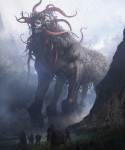


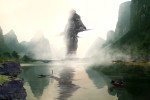

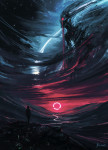

May 13, 2019
(Art) The Clever Sermons of Igor Morski
[image error]
The work of Polish artist and graphic designer Igor Morski, who uses his art to comment on the state of Western society and the world, is a kind of mix of surrealist painting and editorial cartoon, with some photo manipulation thrown in for good measure. Like most Slavic artists, who seem perpetually depressed, Morski focuses on the darker side of things. His work is clever, but only occasionally insightful.
